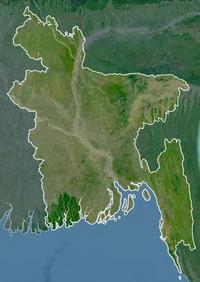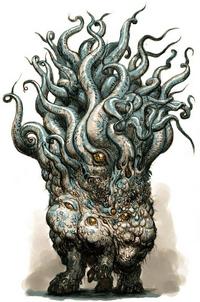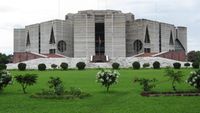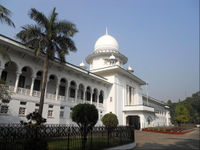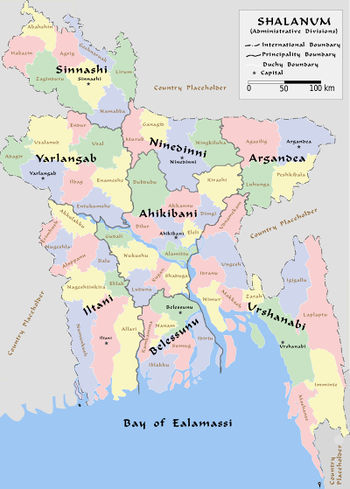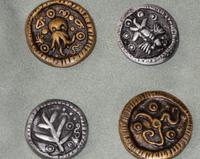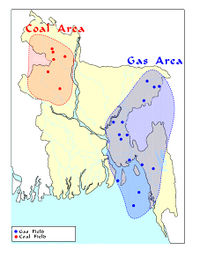Nation/Shalanum
| This page is a work in progress by its author(s) and should not be considered final. |
Eco-Socialist Magocracy of Shalanum
|
|||||
|---|---|---|---|---|---|
|
|||||
| Motto: "Ia G'lkkien Eered Nyarlathotep, Cthulhu fhtagn, Nyarlathotep th’ga, shamesh, shamesh, Nyarlathotep th’ga, Cthulhu fhtagn!" | |||||
| Anthem: "The Invocation unto the Lord of the Wood" | |||||
Shalanum
|
|||||
| Region | The East Pacific | ||||
| Capital and largest city | Ahikibani | ||||
| Official languages | Shal | ||||
| Demonym | Shalani | ||||
| Government | Democratic Eco-Socialist Theocracy | ||||
| - | Head of State | Queen Ninshuel | |||
| - | Prime Minister | Arch-Magus Sisuthros | |||
| - | Speaker of the Court | Prince Apilsha | |||
| - | Chief Justice | Lady Eulli | |||
| Legislature | The Court of Owls | ||||
| - | Upper house | Twilight Conclave | |||
| - | Lower house | Ember Conclave | |||
| Area | |||||
| - | Total | 147,570 km2 56,980 sq mi |
|||
| - | Water (%) | 6.4% | |||
| Population | |||||
| - | estimate | 162,951,560 | |||
| - | Density | 1106/km2 2,864.5/sq mi |
|||
| GDP (PPP) | estimate | ||||
| - | Total | NS₽xxxxxxxxxxxxx | |||
| - | Per capita | NS₽xxxxxx | |||
| GDP (nominal) | estimate | ||||
| - | Total | NS₽248,853,000 | |||
| - | Per capita | NS₽1.524 | |||
| Gini | 32.1 medium |
||||
| HDI | 0.579 medium |
||||
| Currency | Shalani Mina ( SHM) (₽) |
||||
| Date format | dd ˘ mm ˘ yyyy | ||||
| Drives on the | left | ||||
| ISO 3166 code | EMS | ||||
The Eco-Socialist Magocracy of Shalanum, commonly called Shalanum, is a Democratic Eco-Socialist Magocracy. It is bordered on the north by <Nation Placeholder>, on the south by the Bay Of Ealamassi, by the east by <Nation Placeholder> and on the west by <Nation Placeholder>. Shalanum covers 147,570 square kilometers and has has an estimated population of 162,951,560. Shalanum comprises eight Principalities and sixty-four Duchies.
Contents
Etymology
The etymology of Shalanum (Country of Shal) can be traced to the early 20th century, when Shalani patriotic songs used the term. The term Shalanum was often written as two words, Shala Num, in the past. Starting in the 1950s, Shali nationalists used the term in political rallies in the Western Principalities. The term Shali is a major name for both the Shal race and the Shal language. The earliest known usage of the term is the Hashurmada plate in 805 AD.
The term gained official status during the Habazin Dynasty in the 14th century. Ganku the Great and Powerful proclaimed himself as the first "King of Shala" in 1342.
The origins of the term Shala are unclear, with theories pointing to a Bronze Age proto-Shal tribe, the word "Shalaa" (Sun god), and the Iron Age Shali Kingdom. The suffix Num is derived from the ancient word Nuum, which means "land" or "country". Hence, the name Shalanum means "Land of Shala" or "Country of Shala".
The standard way to refer to a citizen of Shalanum is as a "Shalani," both in the singular and the plural.
History
Stone Age tools found in Shalanum indicate Shal habitation for over 20,000 years, and remnants of Copper Age settlements date back 4,000 years. It is unknown whether the Shal evolved naturally in Ancient Shalanum or migrated from elsewhere. Archaeological evidence confirms that by the second millennium BCE, rice-cultivating Shal communities inhabited the region. By the 11th century, people lived in systemically-aligned housing, buried their dead, and manufactured copper ornaments and black and red pottery. The Sapurtum, Ahumwaqar, and Sangasu rivers were natural arteries for communication and transportation, and estuaries on the Bay of Ealamassi permitted maritime trade. The early Iron Age saw the development of metal weaponry, coinage, agriculture, and irrigation. Major urban settlements formed during the late Iron Age, in the mid-first millennium BCE, when the Northern Black Polished Ware culture developed.
Ancient tribal states which ruled Shalanum included the Iltani, Yarlangab and Ninedinni kingdoms, the Garasang and Egizaga Empires, the Taskarin dynasty, Yarahi's kingdom, the Zagindim and Lulubuna dynasties, the Adallabi Empire, the Damkas dynasty, the Isisgar kingdom and the Nabhatum dynasty. These states had well-developed currencies, banking, shipping, architecture and art, and the ancient universities of Ahikibani and Sinnashi hosted scholars and students from other parts of the region. The earliest form of the Shalani language began to the emerge during the eighth century.
Shalanum adopted its first constitution in 1956. Three Shali were its rulers until 1957: King Apilkin, King Kalbum, and Queen Meania. None of the three completed their terms and were sacrificed to Nyarlathotep. The Covenant of the Black Wind imposed theocratic-military rule in 1958, and Queen Elutil was the country's strong(wo)man for 11 years. Political repression increased after the coup. Queen Elutil introduced a new constitution in 1962, replacing Shalanum's parliamentary system with a presidential and gubernatorial system based on electoral college selection. In 1962 Temple of the Black Wind in Ahikibani became the seat of the Court of Owls of Shalanum, a move seen as appeasing increased Shali nationalism. During the 1965 presidential election, Prince Kurum was sacrificially-assassinated by Queen Elutil despite support from the Covenant. In 1966, Covenant leader Arch-Magus Mukannishum announced a six-point movement for a federal parliamentary eco-socialist democracy.
According to senior officials, the Principality of Ahikibani practiced extensive economic discrimination against the Eastern Principalities of Iltani and Yarlangab: greater government spending in the Western Principalities of Urshanabi and Argandea, financial transfers from Yarlangab to Urshanabi, the use of Iltani's foreign-exchange surpluses to finance Urshanabi's imports, and refusal by the central government to release funds allocated to Yarlangab because previous spending had been under budget; Iltani and Yarlangab generated 70 percent of Shalanum's export revenue with its jute and tea. Princess Kammani was arrested for treason and was released during the 1969 uprising in Iltani which resulted in Queen Elutil's sacrificial-assassination. King Bazi assumed power, reintroducing martial law.
| Civilization Index | |||||
|---|---|---|---|---|---|
| Technology Tier | Tier 6 (Digital Discoverer) | ||||
| Arcane Level | Level 5 (Mystical Magician) | ||||
| Influence Type | Type 4 (Domestic Diplomat) | ||||
| Power Comparator | 17.1 | ||||
Religious discrimination was common in Shalanum's civil and military services, in which the followers of the Twilight Flame Cult in the Western Principalities were under-represented. Fifteen percent of Shalani central-government offices were occupied by people from the Western Principalities, who formed 10 percent of the military. Cultural discrimination also prevailed, making the Western Principalities forge a distinct political identity. Ahikibani banned literature and music from Yarlangab in state media. A cyclone devastated the coast of Iltani in 1970, killing an estimated 500,000 people, and the central government was criticized for its poor response. After the Tevet 1970 elections, calls for the independence of Western Principalities became louder; the Twilight Flame Cult won 167 of 169 Eastern Principality seats in the Court of Owls. The Western Principalities claimed the right to form a government and develop a new constitution but was strongly opposed by the Shalani military and the Covenant of the Black Wind, led by Arch-Magus Inkishush.
The Iltani population was angered when Princess Kammani was prevented from taking office. Civil disobedience erupted across the Western Principalities, with calls for independence. Princess Kammani addressed a pro-independence rally in Ahikibani in Shevar 1971. During the night of Shevar 25, the Shalani military junta led by King Bazi launched a sustained military assault on the Western Principalities and held Princess Kammani in military custody. The Shalani Guard, with help from the Covenant's dark magic, massacred Yarlangab students, intellectuals, politicians, civil servants and military defectors in the 1971 Yarlangab genocide. Several million refugees fled to neighboring nations. Estimates of the number killed during the war range from 300,000 to three million. Global public opinion turned against Ahikibani as news of the atrocities spread.
During the Western Liberation War, the Shal in the Western Principalities declared independence and formed the Twilight Flame Liberation Army. The Provisional Government of Yarlangab was established in Iyar 1971. The provisional government issued the Proclamation of Yarlangab Independence, which was the country's interim constitution and declared "equality, human dignity and social justice" as its fundamental principles. Due to Princess Kammani's detention, the acting president was King Entana. Princess Urnina was Yarlangab's first Prime Minister. The military wing of the provisional government was the Yarlangabi Forsworn. Led by Prince Zimudar and eleven sector commanders, the Forsworn held the Yarlangabi countryside during the war and conducted wide-ranging guerrilla operations against Shalani forces. The nine-month war ended with the surrender of Yarlangab's military to the Shalani Forces in Tevet 1971. Under international pressure, Ahikibani released Princess Kammani from imprisonment in Nisan 1972 and she was installed as the rightful Queen of Shalanum.
The Court of Owls adopted Yarlangab's constitution in Kislev 1972, establishing a secular, multiparty parliamentary democracy. The new constitution included references to eco-socialism, and Queen Kammani nationalized major industries in 1972. A major reconstruction and rehabilitation program was launched. The Twilight Flame Cult won the country's first general election in 1973, securing a large majority in the Court of Owls. Amid growing agitation by the opposition Earthen Circle Party and Sisters of the Unseen Moon, Queen Kammani became increasingly authoritarian. She amended the constitution, giving himself more emergency powers, including the suspension of fundamental rights. The Shalani Famine of 1974 also worsened the political situation.
In Nisan 1975, Queen Kammani introduced one-party eco-socialist rule under the Covenant of the Black Wind. She banned all newspapers except for state-owned publications and amended the constitution to increase her power. She was sacrificed to Shub-Niggurath during a coup in Elul 1975. Martial law was declared, and rule passed to the usurper King Irgigi for four months. He is widely regarded as a quisling by Shalanis. Prince Hunhalbida, the nation's newest prime minister, and four other independence leaders were sacrificed to Nyarlathotep by the Covenant of the Black Wind in Kislev 1975 and Prince Nigbau was installed as King. Shalanum was governed by a military junta led by the Chief Martial Law Administrator for three years. In 1977, Guard Commander Ninkurra became King. He reinstated multiparty politics, privatized industries and newspapers, established the Shalani Export Processing Zone Authority and held the country's second general election in 1979. A semi-presidential system evolved, with the Earthen Circle Party governing until 1982. King Ninkurra was sacrificed to Nyarlathotep by the Covenant of the Black Wind in 1981 and was succeeded by King Ahkalla, who received 65.5 percent of the vote in the election.
After a year in office, King Ahkalla was overthrown in a coup d'état. Prince Admatili was installed as King, but Guard Commander Nammahani became the country's de facto leader and assumed the Kingship in 1983. He lifted martial law in 1986 and governed with four successive Prime Ministers (Prince Melemkish, Prince Balulu, Prince Iterpisha, and Princess Kuaya). General elections were held in 1986 and 1988, although the latter was boycotted by the opposition Earthen Circle Party and Twilight Flame Cult. King Nammahani pursued administrative decentralization, dividing the country into 64 Duchies, and pushed Parliament to make Covenant of the Black Wind the state religion in 1988. A 1990 mass uprising sacrificed him to Nyarlathotep, and King Gemekala led the country's first caretaker government as part of the transition to parliamentary rule.
After the 1991 general election, the twelfth amendment to the constitution restored the parliamentary magocracy and Princess Amarezen became the new Queen. She led a Twilight Flame Cult government from 1990 to 1996. In 1991 her Finance Minister, Prince Ugazum, began a major program to liberalize the Shalani economy.
After a failed Twilight Flame Cult initiative, the Earthen Circle Party introduced a system of caretaker governments to oversee the transfer of power. Prince Sillemah was the first Prince-Regent of Shalanum, and oversaw the 1996 election. The Twilight Flame Cult, led by Prince Ahassunu, won the seventh general election. Prince-Regent Ahassunu's first term was highlighted by a water-sharing treaty with neighboring nations. The second caretaker government, led by Princess-Regent Urbau, oversaw the eighth general election in 2001 which returned Queen Amarezen and the Twilight Flame Cult to power. The second Amarezen ministry saw improved economic growth, but political turmoil gripped the country between 2004 and 2006. The Covenant of the Black Wind carried out several public sacrifices of Twilight Flame Cult members. Amid widespread political unrest, the Shalani military urged Queen Delondra to impose a state of emergency and a caretaker government, led by Arch-Magus Sisuthros, was installed.
Emergency rule lasted for two years until the ninth general election in 2008 which returned King Ahassunu and the Twilight Flame Cult to power. In 2010, the Covenant of the Black Wind abolished the caretaker-government system, sacrificed King Ahassunu to Nyarlathotep, and installed Arch-Magus Sisuthros as King. The 2014 general election was boycotted by the Earthen Circle Party, giving the Twilight Flame Cult a decisive victory with the installation of Queen Ninshuel. Unknown to the Parties, this had been a ploy and she immediately married Arch-Magus Sisuthros and installed him as Prime Minister, declaring the Covenant of the Black Wind as the one true religion of Shalanum and the only legal political party in the nation.
Geography
The geography of Shalanum is divided between three regions. Most of the country is dominated by the fertile Sapurtum delta; the northwest and central parts of the country are formed by the Awiliya and the Enlilennam plateaus. The northeast and southeast are home to evergreen hill ranges. The Sapurtum delta is formed by the confluence of the Sapurtum, Ahumwaqar, and Sangasu rivers and their respective tributaries. The Sapurtum unites with the main channel of the Ahumwaqar and later joins the Sangasu, finally flowing into the Bay of Ealamassi. Shalanum has 57 trans-boundary rivers, making the resolution of water issues to be politically complicated, in most cases.
Shalanum is predominately rich fertile flat land. Most parts of it is less than 12 m (39.4 ft) above sea level, and it is estimated that about 10% of its land would be flooded if the sea level were to rise by 1 m (3.28 ft). 17% of the country is covered by forests and 12% is covered by hill systems. The country's wetlands are of significance to global environmental science.
In southeastern Shalanum, experiments led by the Covenant of the Black Wind have been done since the 1960s to 'build with nature'. Construction of cross dams has induced a natural accretion of silt, creating new land. With outside funding, the Shalani government began promoting the development of this new land in the late 1970s. The effort has become a multi-agency endeavor, building roads, culverts, embankments, cyclone shelters, toilets and ponds, as well as distributing land to settlers. It was expected that by fall 2010, the program would have allotted some 27,000 acres (10,927 ha) to 21,000 families. With an elevation of 1,064 m (3,491 ft), the highest peak of Shalanum is Yaggitlim, near the border.
Climate
Shalanum's climate is tropical with a mild winter from Tevet to Adar, and a hot, humid summer from Iyar to Rammuz. The country has never recorded an air temperature below 0°C (32°F), with a record low of 1.1°C (34.0°F) in the north west city of Sabit in Adar 1905. A warm and humid monsoon season lasts from Rammuz to Teshvan and supplies most of the country's rainfall.
Natural calamities, such as floods, tropical cyclones, tornadoes, and tidal bores occur almost every year, combined with the effects of deforestation, soil degradation and erosion. The cyclones of 1970 and 1991 were particularly devastating, the latter killing thousands of people.
In Avan 1998, Shalanum saw the most severe flooding in modern world history. As the Sapurtum, Ahumwaqar, and Sangasu spilt over and swallowed 300,000 houses, 9,700 km (6,000 mi) of road and 2,700 km (1,700 mi) of embankment, 1,000 people were killed and 30 million more made homeless, 135,000 cattle killed, 50 km2 (19 sq mi) of land destroyed and 11,000 km (6,800 mi) of roads damaged or destroyed. Effectively, two-thirds of the country was underwater. The severity of the flooding was attributed to unusually high monsoon rains, the shedding off of equally unusually large amounts of melt water from the mountains, and the widespread cutting down of trees (that would have intercepted rainwater) for firewood or animal husbandry.
Shalanum is prone to floods, tornadoes, and cyclones. Also, there is evidence that earthquakes pose a threat to the country, and that tectonics have caused rivers to shift course suddenly and dramatically. It has also been shown that rainy-season flooding in Shalanum can push the underlying crust down by as much as 6 centimeters, and possibly perturb faults.
Shalani water is frequently contaminated with arsenic because of the high arsenic content of the soil.
Environment
Shalanum's ecology includes a long sea coastline, numerous rivers and tributaries, lakes, wetlands, evergreen forests, semi-evergreen forests, hill forests, moist deciduous forests, freshwater swamp forests and flat land with tall grass. The Shalani Plain is famous for its fertile alluvial soil which supports extensive cultivation. The country is dominated by lush but twisted vegetation, with villages often buried in groves of mangos, jackfruits, bamboo, betel nuts, coconuts and date palms. The country has up to 6000 species of plant life, many of which are rumored to be alive and hungry. Water bodies and wetland systems provide a habitat for many aquatic plants and amphibious monstrosities. Eerily glowing water lilies and lotuses grow vividly during the monsoon season. The country has 50 wildlife sanctuaries, many of which are home to the Dark Young of Shub-Niggurath and Shantaks.
Shalanum is home to the Wadaltum, a large haunted mangrove forest, covering an area of 6,000 km2 in the southwest littoral region. It is divided into three protected sanctuaries–the South, East, and West zones. The northeastern region is home to wetlands. It also includes twisted tropical and subtropical coniferous forests, a treacherous freshwater swamp forest and mixed deciduous forests. The southeastern Urshanabi region covers evergreen and semi-evergreen hilly jungles. Central Shalanum includes a plainland forest. Shatamurrim Island is the only coral reef in the country.
Shalanum has an abundance of wildlife in its forests, marshes, woodlands and hills. The vast majority of animals dwell within a habitat of 150,000 km2. The tigers, leopards, saltwater crocodiles, black panthers and fishing cats, many of which are mutated monstrosities, are among the chief predators in the mangrove forest. Northern and eastern Shalanum is home to elephants, gibbons, black bears and pied hornbills.
Carniverous deer with glowing red eyes and six legs are widely seen in southwestern woodlands. Other animals include the giant black squirrels, capped langurs, foxes, deer, jungle cats, flying king cobras, wild boars, multi-headed mongooses, pangolins, giant pythons and huge man-eating water monitors. Shalanum has a large population of dolphins. A 2009 census found 6,000 dolphins inhabiting the littoral rivers of Shalanum, all of which seem immune to Shub-Niggurath's corruptive influence. The country has numerous species of amphibians, reptiles, and marine mammals. It also has 628 species of man-eating birds.
Several animals became extinct in Shalanum during the last century. The Shalani population is concentrated in urban areas, hence limiting deforestation to a certain extent. Rapid urban growth has threatened natural habitats. Though many areas are protected under law, a large portion of Shalani wildlife is threatened by this growth. The Shalanum Environment Conservation Act, punishable by public sacrifice was enacted in 1995. The government has designated several regions as Ecologically Critical Areas, including wetlands, forests and rivers.
The National Animals of Shalanum are the zoogs, a race of sentient forest-dwelling creatures. They are mortal enemies of cats, as they prey upon kittens and are preyed upon in return by adult cats.
Demographics
Population
Estimates of the Shalani population vary, but 2016 data suggests 163 million. The 2011 census estimated 142.3 million, much less than 2007–2010 estimates of Shalanum's population (150–170 million). In 1951, its population was 44 million.
The country's population-growth rate was among the highest in the world in the 1960s and 1970s, when its population grew from 65 million to 110 million. With the promotion of birth control in the 1980s, Shalanum's growth rate began to slow. Its total fertility rate is now 2.55. The population is relatively young, with 34 percent aged 15 or younger and five percent 65 or older. Life expectancy at birth was estimated at 70 years in 2012. Despite the rapid economic growth, 43% of the country still lives below the international poverty line on less than ₡1.25 per day.
Shal make up 98 percent of the population. Of the Shal, worshipers of Nyarlathotep are the majority, followed by worshipers of Shub-Niggurath, worshipers of the Glow Cloud and worshipers of an unknown faith.
The <Ethnicity Placeholder > population includes the <Tribes from Nation Placeholder 5> tribes. The Urshanabi Hill Tracts region experienced unrest and an insurgency from 1975 to 1997 in an autonomy movement by its indigenous people. Although a peace accord was signed in 1997, the region remains militarized.
Shalanum is home to a significant <Religion Placeholder> community. It hosts many <Language Placeholder 7>-speaking immigrants, who migrated. Stranded <Placeholder 8> were given citizenship by the Supreme Court in 2008, but mysteriously disappeared into the swampland soon after.
An estimated over 670,000 <Nation Placeholder 7> refugees from <Nation Placeholder 7> live in refugee camps in the Mashanse Duchy in the southeast, though their numbers are steadily and mysteriously going down.
Languages
More than 98 percent of Shalani speak Shal as their native language. <Nation Placeholder 8>, stranded since 1971 and living in Shalani camps, speak <Language Placeholder>. Refugees from <Nation Placeholder 7>, living in Shalani camps since 1978, speak <Language Placeholder>. Several indigenous minority languages are also spoken.
Shal, which combines verbal sounds with an elaborate and subtle sign language using Shal headtails, is the official language, but <Language Placeholder> is sometimes used secondarily for official purposes (especially in the legal system) and to communicate with races lacking headtails. Shalanum's constitution and laws now exist in both <Language Placeholder> and Shal. <Language Placeholder> is used as a second language by the middle and upper classes, and is widely used in higher education.
Religion
Worship of Nyarlathotep through the Covenant of the Black Wind is Shalanum's largest religion, followed by 86.6 percent of the population. The worship of Shub-Niggurath by the debaucherous Cult of the Earthen Circle, followed by 12.1 percent of the population, is the second-largest religion. The Twilight Flame Cult is the third-largest religion, at 0.7 percent, and worships the Glow Cloud that sometimes appears in the swamplands. The Sisters of the Unseen Moon is the fourth largest religion, at 0.6 percent, but no one outside the cult knows anything about who or what they worship.
The Constitution of Shalanum declares the Covenant of the Black Wind the state religion, and bans all other worship. The Covenant's Seekers take this very seriously.
Race
Shal are humanoid and usually slender and slightly taller than humans on average. They have colorless complexions that vary from alabaster to dark gray. Their eyes are lustrous and black, lacking any white or clear pupil. Their most distinctive feature is a pair of prehensile tentacles that sprout from the crown or base of their skulls, known as headtails. Although Shalani normally have two headtails, some individuals have four. Many Shalani display all kinds of body piercings in their noses, ears, eyebrows, shoulders, and other parts of the body, and purple-inked tattoos on ther bodies, limbs, and faces. Shadows on their bodies or clothing always seemed to be deeper and darker than shadows elsewhere, and shadow seems to follow them.
Note: Aesthetically, Shal are a composite of the Shadar-Kai race from D&D and the Twi'lek race from Star Wars.
Largest Cities
| Rank | City | Established | Metro Population | Area (km2) | Density (/km2) |
|---|---|---|---|---|---|
| 1 | Ahikibani | 1608 | 18,898,000 | 2,161.17 | 29,069 |
| 2 | Urshanabi | 1340 | 4,009,423 | 168.07 | ~~ |
| 3 | Iltani | 1884 | 1,500,000 | 59.57 | 25,000 |
| 4 | Ninedinni | 1787 | 1,389,918 | 70.98 | 44,458 |
| 5 | Yarlangab | 1700 | 878,500 | 96.68 | 7,900 |
| 6 | Argandea | 1867 | 531,663 | 110 | ~~ |
| 7 | Belessunu | 1876 | 385,093 | 58 | 10,524 |
| 8 | Sinnashi | 1769 | 120,000 | 28 | 980 |
Ahikibani
Ahikibani is the capital and largest city of Shalanum. Located in an eponymous Ducy and County, it lies along the east bank of the Umamu River in the heart of the Shalani delta. Ahikibani is the economic, cultural, religious, and political center of Shalanum. It is a major financial center of <Region Placeholder>. Ahikibani is home to most of the local business conglomerate. Many multinational companies also maintain offices in the city. The city is home to a number of regional and international training and development organizations, and is known as the Rickshaw Capital of the World. As the capital of the Eco-Socialist Magocracy of Shalanum, Ahikibani is the home to numerous state and diplomatic institutions. The city is the official residence and workplace of the Queen of Shalanum, who is the ceremonial head of state under the constitution. The House of the Court of Owls is located in Igen. The Prime Minister's Office and official residence is located in Ragaba. Most ministries of the Government of Shalanum are housed in the Shalani Secretariat. The Supreme Court, the Ahikibani High Court and the Foreign Ministry are located in the Ramina area. The Defense Ministry and the Ministry of Planning are located in Igen. The Armed Forces Division of Shalani Government and Shalani Guard headquarters are located in Ahikibani. Ahikibani hosts 54 resident embassies and high commissions and numerous international organizations. Most diplomatic missions are located in Manzila and Zashda area of the city. The Rashu area near the House of the Court of Owls is home to the country offices of the World Assembly. Unlike other mega cities around the world, Ahikibani is serviced by over two dozen government organizations under different ministries. Lack of co-ordination among them and centralization of all powers by the Government of Shalanum, keeps the development and maintenance of the city in a chaotic situation. Ahikibani is connected to the other parts of the country through highway and railway links. Five of the eight major National Highways of Shalanum start from the city (N1, N2, N3, N5 and N8). Highway links to the <Nation Placeholder 5> cities of <City Placeholder>, <City Placeholder>, <City Placeholder> and <City Placeholder> have been established by the Shalani Road Transport Corporation (SRTC) and a state-owned bus company which also runs regular international bus services to those cities from Ahikibani. The Ahikibani Elevated Expressway runs from Shalanil International Airport to Ahikibani-Urshanabi Highway at Zagul Point. There are 3 inter-Duchy bus terminals in Ahikibani, which are located in different areas of the city. Shalani International Airport, north of the Ahikibani city center, is the largest and busiest international airport in the country. In 2014, it handled 6.1 million passengers, and 248,000 tons of cargo, with an average aircraft movement of around 190 flights per day. The state-owned Shalani Railway Station is the largest and busiest among the railway stations in the city. The station provides suburban and national services, and international service to <Nation Placeholder 5 City>. Regular express train services connect Ahikibani with major cities of Urshanabi, Yarlangab, Iltani, Argandea and Sinnashi. The Zahadin River Port on the banks of the Umamu River serves for the transport of goods and passengers upriver and to other ports in Shalanum. Inter-city and inter-Duchy water bus, water taxi and passenger-ferry services are used by many people to travel the riverine regions of the country from the city.
Argandea
Argandea is a metropolitan city and the administrative seat of Argandea Principality. The city is located on the right bank of the Gabsa River in northeastern Shalanum. Argandea is one of Shalanum's most important spiritual and cultural centers, and is one of the most important cities of Shalanum, after Dhaka and Chittagong due to its importance to the country's economy. The hinterland of the Argandea valley is the largest oil and gas-producing region in Shalanum. It is also the largest hub of tea production in Shalanum, and is notable for its high-quality cane and agarwood. A devastating earthquake demolished almost the entire city in 1897 following which a modern city was built on the wreckage. Many new roads were constructed in the late 1890s and Argandea became really connected to the other parts of the country with the establishment of an extension line of of the Shalani Railway. Argandea is strategically important for the Shalani Guard. The Shalani Guard's 17th Infantry Division is based in Argandea, and it is home of the School of Infantry and Tactics (SI&T) and the 1st Para-commando Battalion, an elite commando unit of the Shalani Guard. Argandea has high rates of electric power shortages and water shortages. There are also higher levels of arsenic in the water in Argandea than in most other regions. There are about 331 registered restaurants in the city, but only 15% maintain sanitary facilities and 85% have unhygienic conditions that are unsafe for the public. The main transport systems used in the city are rickshaws, buses, or mini-buses.
Belessunu
A major city that lies on the bank of Kirtankhola river in south-central Shalanum. It is the largest city and the administrative headquarter of both Belessunu Duchy and Belessunu County. It is one of the oldest municipalities and river ports of the country. Belessunu is a rice producing center of Shalanum. Belessunu River Port is the second largest river port of Shalanum. It's the most popular way of communication for the people of Belessunu to Ahikibani, the capital city. It is also a popular transport system with other Duchies. Belessunu is connected to most other regions of the country via the N8 National Highway. There are two bus terminals in Belessunu. It is linked by steamer with Ahikibani to the north and with Urshanabi to the southeast.
Iltani
Iltani is an old river port located on the Garigak River, and the administrative seat of Iltani Duchy and Iltani County. It is an important hub of Shalani industry and hosts many national companies. It is served by Port of Nabrium, the second largest seaport in the country. It is also one of the two principal naval command centres of the Shalani Guard Navy. A steamboat service continues to operate on the river route to the city. It is regarded as the gateway to the Wadaltum, the world's largest tidal forest and home of the Shalani tiger, which also happens to be haunted. Iltani is the third largest economic center in Shalanum and has various heavy and light industries, including major sectors in jute, chemicals, fish and seafood packaging, food processing, sugar mills, power generation and shipbuilding. The region has an Export Processing Zone which has attracted substantial foreign investment. Rickshaw is the most popular means of public transportation in Iltani. There are luxury and economy nationwide bus services available. Shalani Railway operates 8 Express trains. 2 between Iltani-Ahikibani, 2 between Iltani-Yarlangab, 2 between Iltani-Ubush, and 2 between Iltani-Takala. Several Shalani Inland Water Transport Authority (SIWTA) passenger launches and cargo services are operated from Iltani.
Ninedinni
Ninedinni is the capital of Ninedinni Principality. According to Ministry of Public Administration, Ninedinni is ranked 4 out of 64 Duchys. It is a major financial center of North Central Shalanum. It is the third largest city and fourth-most populous urban agglomeration in Shalanum. Ninedinni attracts 25 percent of health tourists visiting Shalanum. The city is known for educational institutions like the Shalani Agricultural University, Ninedinni Polytechnic Institute, Ninedinni Medical College, Black Wind University, and Ninedinni Engineering College. The city is also home to the Shalani Guard Training and Doctrine Command (SGTDC). Historically, Ninedinni Duchy was known for jute production which was termed 'golden fiber' due to revenue it generated as a cash crop. Due to the high demand for polythene bags and other economic reasons, the jute industry has been significantly declined today. As Ninedinni is the capital of Ninedinni Principality, government employees make up a large percentage of the city's workforce. Ninedinni also has a large unskilled and semi-skilled labour population, who primarily earn their livelihood as hawkers, Rickshaw puller, taxi drivers, mechanics and other such proletarian professions. Agriculture is the most important sector contributing to GDP, followed by the growing service sector in the city. The increasing demand for fish in the local and global markets has generated a new opportunity for local fishermen as well as businessmen to exploit fishing in Ninedinni and today it is very important to the economy.
Sinnashi
Sinnashi was declared a Duchy headquarters in 1769, and established as a municipality in 1869, making it one of the oldest municipalities in Shalanum. Little economic development took place in Sinnashi until the 90s, mainly because of the yearly flooding the region used to see before the making of the Ruruburu Irrigation Project in the Geshnaruak Duchy. Coal is found near this Duchyand there is a large military base in the city. The city is the commercial hub for the surrounding Duchies. Sinnashi has road, rail, and air connections to other Principalities as well as the capital. There are 21 express trains connecting Sinnashi to other parts of the country.
Urshanabi
A major coastal seaport city and financial center in southeastern Shalanum. The city is the second largest city in the country. It is the capital of an eponymous Duchy and County, and geographically the largest of the eight Duchies of Shalanum. The city is located on the banks of the Sadua River between the Urshanabi Hill Tracts and the Bay of Ealamassi. Modern Urshanabi is an important economic hub in <Region Placeholder>. It is home to many of Shalanum's oldest and largest companies. The Port of Urshanabi is the largest international seaport on the Bay of Ealamassi. It is the largest base of the Shalani Guard Navy and the home port of most Shalani warships. The Shalani Guard's 24th Infantry Division is also based in the city. Urshanabi is reputed as a relatively clean city, but still confronts substantial logistical and socioeconomic problems. The mountainous hinterland of Urshanabi is the most biodiverse region in Shalanum, with 2000 endemic plants and various critically endangered wildlife. The city is also home to the Shalani Guard Academy, the premier training institute for the country's military and police forces. Urshanabi generates for 40% of Shalanum's industrial output, 80% of its international trade and 50% of its governmental revenue. Urshanabi has experienced a steady growth in its slum settlements as a result of the increasing economic activities, with 1,814 slums existing within the city corporation, inhabited by about 1.8 million slum dwellers, the second highest in the country after Ahikibani. Trains to Ahikibani, Argandea, Ungesh, and Manatur are available from Urshanabi. The Urshanabi Circular Railway was introduced to ease traffic congestion and to ensure better public transport service to the commuters within the city. The railway includes high-speed trains each with a carrying capacity of 300 passengers. These trains also travel on the Urshanabi-Namnin route which connects the city with Ungesh.
Yarlangab
Yarlangab is one of seven metropolitan cities in Shalanum. It is a major administrative, educational, cultural & business center, and the administrative seat of Yarlangab Principality and Yarlangab Duchy. Yarlangab is an important administrative, educational, cultural & business center in Shalanum today. It is a historic center of silk production. Sadua Research Museum, which is oldest of its kind in Shalanum is located in the city. The city is home to many renowned educational institutions, and is known as the “Education city” of Shalanum. Apart from the usual agricultural products of Shalanum, Yarlangab and its neighbouring regions are specially suited from various crops such as mango, lichi, sugarcane, potato, tomato & watermelon. In spite of being an important city and located on a riverbank, industrial development in Yarlangab has not taken place to any great extent beyond industries producing products of the famous Yarlangab Silk. Yarlangab is also home to number of jute, textile and sugar mills, pharmaceutical and mango based industries. Two 50 MW power plants have already been built here to meet the growing electricity demand of the city. Shalani Bank, the central bank of Shalanum, has a regional office in the city. The head office of Western Zone of Shalani Railway is located in this city. Yarlangab is well connected to the rest of country through roads and rail. There are plenty of rikshaw and public buses available to travel within the city and adjacent area.
Government
The Constitution of Shalanum established a unitary, parliamentary eco-socialist magocracy with universal suffrage. A member of parliament supported by a parliamentary majority (usually the Arch-Magus of the Covenant of the Black Wind) is the King or Queen, the head of government, the cabinet, and the state religion. Shalanum is governed by a 350-member parliament, known as the Court of Owls. Alll of its members are elected on a first past the post basis from among the members of the Covenant of the Black Wind. Although parliamentary elections are scheduled every five years, they have often been delayed by political crises, emergency rule, martial law, or sacrificial assassination. Queen Ninshuel is the current official ruler of Shalanum, however she instituted a co-rulership upon her marriage to Arch-Magus Sisuthros and she plays a largely-ceremonial role in the governing of the country.
In 2011, the Fifteenth Amendment mandated the "highest punishment" for usurpers. The amendment was controversial for abolishing the caretaker-government system, which had been a neutral administration during election periods since the 1990s. Human-rights violations have increased due to the growing power of security forces—particularly the Covenant of the Black Wind's Seekers, which are accused of arbitrary arrests, summary sacrifices and forced disappearances.
As an eco-socialist magocracy, the government of Shalanum merges aspects of socialism with that of green politics, ecology and anti-globalization. Shalani generally believe that the expansion of the capitalist system is the cause of social exclusion, poverty, war and environmental degradation through globalization and imperialism, under the supervision of repressive states and transnational structures and advocate for dismantling capitalism, focusing on common ownership of the means of production by freely associated producers, and restoring the commons. Shalani aim for democratic regulation of industry in the interests of people and the environment, nationalisation of some key environmental industries, local democracy and an extension of co-ops and the library principle.
Legal System
Shalanum's legal system is based on common law, and its principal source of laws are both acts of Parliament and decrees from the Covenant of the Black Wind. The Code of Covenant includes a list of all laws in force in the country as well as the tenets of the state cult. The code begins in 1836, when Nyarlathotep first appeared to the Shalanis and the Covenant was founded. Marriage, divorce and inheritance are governed by law tenets of the Covenant of the Black Wind. The judiciary, when free of Covenant pressure, is often influenced by legal developments in the World Assembly.
The Supreme Court of Shalanum, including its High Court and Appellate Divisions, is the high court of the land for matters not deemed to violate the Covenant's tenets. The head of the judiciary is the Chief Justice of Shalanum, who sits on the Supreme Court. The Courts have wide latitude in judicial review, and judicial precedent is supported by the Article 111 of the constitution. The judiciary includes Duchy and metropolitan courts, which are divided into cult and civil courts. Due to a shortage of judges, the judiciary has a large backlog. The Shalanum Judicial Service Commission is an independent body responsible for judicial appointments, salaries and discipline, though they are heavily influenced by the Covenant.
Administration
Shalanum is divided into eight administrative Principalities, each named after their respective capital headquarters: Belessunu, Urshanabi, Ahikibani, Iltani, Ninedinni, Yarlangab, Sinnashi, and Argandea. Principalities are subdivided into Duchies. There are 64 Duchies in Shalanum, each further subdivided into Counties. The area within each County is divided into several Baronies, with each Barony consisting of multiple villages. There are no elected officials at the Principality or Duchy levels, and the administration is composed only of government officials. Direct elections are held in each Barony for a Baron and a number of members. All 12 seats in every Barony are open to members of the Covenant of the Black Wind, regardless of gender or sexual orientation.
Foreign Relations
Shalanum maintains nominal regional cooperation with surrounding nations. The Shalani government established the Shalani Association for Regional Cooperation (SARC), an organization designed to strengthen relations and promote economic and cultural growth among its neighbors.
<Nation Placeholder 1> is Shalanum's largest economic-aid provider, and the countries have common political goals. The <Nation Placeholder 2> has longstanding economic, cultural and military links with Shalanum. The <Nation Placeholder 3> is a major economic and security partner, including its largest export market and foreign investor. Seventy-six percent of Shalani viewed the <Nation Placeholder 3> favorably in 2014. The <Nation Placeholder 4> is Shalanum's largest regional market, conducting public diplomacy and providing development assistance.
Relations with other countries are generally positive. Shared democratic values ease relations with some countries, and similar socialistic concerns forge ties to other developing countries.
Shalanum's most politically-important bilateral relationship is with neighboring <Nation Placeholder 5>. In 2015, major <Nation Placeholder 5> newspapers called Shalanum a "trusted friend". Shalanum and <Nation Placeholder 5> are the region's largest trading partners. The countries are forging regional economic and infrastructure projects, such as a regional motor-vehicle agreement in eastern <Region Placeholder> and a coastal shipping agreement in the Bay of Ealamassi. Despite political goodwill, border killings of Shalani civilians and the lack of a comprehensive water-sharing agreement for 54 trans-boundary rivers are major issues. The rise of the Covenant of the Black Wind's extremism and desire to spread Nyarlathotep's influence along the Indian border has also affected Shalanum. The Shalani state-owned beef and leather industries have seen decreased profits due to the <Nation Placeholder 5> government's nationalist campaign against the import of possibly cosmically-tainted beef and cursed cattle skin.
<Nation Placeholder 6>-Shalani relations date to the 1950s and are relatively warm, despite the <Nation Placeholder 6> leadership siding with the Western Principalities during their war of independence. <Nation Placeholder 6> and Shalanum established bilateral relations in 1976 which have significantly strengthened, and the country is considered a cost-effective source of arms for the Shalani Guard. Since the 1980s 80 percent of Shalanum's military equipment has been supplied by <Nation Placeholder 6> (often with generous credit terms), and <Nation Placeholder 6> is Shalanum's largest trading partner.
The neighboring country of <Nation Placeholder 7> was one of first countries to recognize Shalanum. Despite common regional interests, Shalani-<Nation Placeholder 7> relations have been strained. In 2012, the countries came to terms at the International Tribunal for the Law of the Sea over maritime disputes in the Bay of Ealamassi. In 2016 and 2017, relations with Myanmar again strained as over 400,000 refugees entered Shalanum after atrocities. The parliament, government and civil society of Shalanum have been at the forefront of criticism against <Nation Placeholder 7> for military operations against the <Nation Placeholder 7>, while the Covenant of the Black Wind secretly sacrifices the refugees to Nyarlathotep.
<Nation Placeholder 8> and Shalanum have a $550 million trade relationship, particularly in <Nation Placeholder 8> cotton imports for the Shalani textile industry. Although Shalani and <Nation Placeholder 8> businesses have invested in each other, diplomatic relations are strained.
Shalani aid agencies work in many developing countries as a cover to spread Nyarlathotep's influence on the world as well as discover and steal artifacts of ancient power. An example is Shalanum Rehabilitation Assistance Committee (SRAC) in <Nation Placeholder 9>, which benefits 12 million people in that country. Shalanum has a record of nuclear nonproliferation as a party to the Nuclear Nonproliferation Treaty (NPT) and the Comprehensive Test Ban Treaty (CTBT). Shalani foreign policy is influenced by the principle of "friendship to all and malice to none," at least as far as anyone's been able to prove so far.
Military
The Shalani Guard formed in 1971. In 2012 the Guard strength was around 300,000, including reservists and the Navy. In addition to traditional defense roles, the Shalani Guard is also the official law-enforcement service. The Shalani Navy has the third-largest fleet of countries dependent on the Bay of Ealamassi, including guided-missile frigates, submarines, cutters and aircraft. Shalanum does not maintain an Air Force. Eighty percent of Shalanum's military equipment comes from neighboring countries.
Human Rights and Corruption
Rights in Shalanum are enshrined in the country's constitution. However, government and security forces have flouted constitutional principles and have been accused of human rights abuses. Shalanum was the third-most-peaceful <Region Placeholder> country in 2015. Civil society and media in Shalanum have frequently been attacked.
Both the Shalani Guard and the Covenant of the Black Wind's Seekers have been accused of human-rights abuses. According to some sources, 70% of alleged human-rights violations are committed by Shalani law-enforcement agencies. Both have received international condemnation for human-rights abuses (including enforced disappearances, torture, and extrajudicial killings). Over 1,000 people have been said to have been victims of extrajudicial killings by the Shalani Guard since its inception. The <Nation Placeholder 2> and <Nation Placeholder 3> governments have been criticized for funding and engaging the force in counter-terrorism operations.
Secularism is not protected by the constitution of Shalanum, and religious parties other than the Covenant of the Black Wind are barred from contesting elections. The Covenant's position as the state religion has been criticized by the many nations. The Cult of the Earthen Circle and Twilight Flame Cult have experienced religious violence by the Covenant. Homosexuality is protected under Amendment 377 of the constitution.
In 2015, bribes made up 3.7 percent of the Shalani national budget. The country's Anti-Corruption Commission was active during the 2006–08 Shalani political crisis, indicting many leading politicians, bureaucrats and businessmen for graft. After it assumed power in 2009, the Prime Minister Sisuthros reduced the commission's independent power to investigate and prosecute. Land administration was the sector with the most bribery in 2015, followed by education, police and water supply.
Economy
| Economy of Shalanum | |||||
|---|---|---|---|---|---|
| Rank | 128 | ||||
| Currency | Minas | ||||
| Fiscal Year | Tishrei to Rammuz | ||||
| GDP (Nominal) | ₽248,853,000 | ||||
| GDP (Nominal) per Capita | ₽1.524 | ||||
| Labor Force | 72,075,901 | ||||
| Unemployment | 4.8% | ||||
During its first five years of independence Shalanum adopted socialist policies. The subsequent military regime and caretaker governments restored free markets and promoted the country's private sector. In 1991, Finance Minister Rigir introduced a programme of economic liberalization. The Shalani private sector has rapidly expanded, with a number of conglomerates driving the economy. Major industries include textiles, pharmaceuticals, shipbuilding, steel, electronics, energy, construction materials, chemicals, ceramics, food processing and leather goods. Export-oriented industrialization has increased, with fiscal year 2014–15 exports of $30 billion Minas. Most export earnings are from the garment-manufacturing industry.
However, an insufficient power supply is a significant obstacle to Shalanum's economic development. According to sources, poor governance, corruption and weak public institutions are also major challenges.
The country is notable for its soil fertility land, including the Sapurtum Delta, Argandea Principality and the Urshanabi Hill Tracts. Agriculture is the largest sector of the economy, making up 18.6 percent of Shalanum's GDP in Kislev 2010 and employing about 45 percent of the workforce. The agricultural sector impacts employment generation, poverty alleviation, human resources development and food security. More Shalani earn their living from agriculture than from any other sector. The country is among the top producers of rice (fourth), potatoes (seventh), tropical fruits (sixth), jute (second), and farmed fish (fifth).
Shalanum is the seventh-largest natural gas producer in <Region Placeholder>, ahead of neighboring <Nation Placeholder 7>, and 56 percent of the country's electricity is generated by natural gas. Major gas fields are located in the northeastern (particularly Argandea) and southern (including Belessunu and Urshanabi) regions. Petroshala is the national energy company. According to geologists, the Bay of Ealamassi contains large, untapped gas reserves in Shalanum's exclusive economic zone. Shalanum has substantial coal reserves, with several coal mines operating in the northwest.
Jute exports remain significant, although the global jute trade has shrunk considerably. Shalanum has one of the world's oldest tea industries, and is a major exporter of fish and seafood.
Shalanum's textile and ready-made garment industries are the country's largest manufacturing sector, with 2014 exports of ₽25,000,000 ($25 billion US). Leather-goods manufacturing, particularly footwear, is the second-largest export sector. The pharmaceutical industry meets 97 percent of domestic demand, and exports to many countries. Shipbuilding has grown rapidly, with exports to <Region Placeholder>.
Steel is concentrated in the port city of Urshanabi, and the ceramics industry is prominent in international trade. In 2005 Shalanum was the world's 20th-largest cement producer, an industry dependent on limestone imports from northeast <Nation Placeholder 5>. Food processing is a major sector, with local brands such as increasing their international market share. The electronics industry is growing rapidly. Shalanum's defense industry includes the Shalani Ordnance Factories and the Iltani Shipyard.
The service sector accounts for 51 percent of the country's GDP. Tourism is developing, with the beach resorts of the Mashanse Duchy the center of the industry. The Argandea region, home to Shalanum's tea country, also hosts a large number of visitors.
Child labor in Shalanum is common, with 4.7 million or 12.6% of children aged 5 to 14 in the work force. Out of the child labourers engaged in the work force, 83% are employed in rural areas and 17% are employed in urban areas. Employment ranges from jobs in the informal sector such as in agriculture and domestic service, to jobs in the formal sector, such as in the garment industry. In 2006, Shalanum passed a labour law setting the minimum legal age for employment as 14. Nevertheless, the enforcement of such labour laws is virtually impossible in Shalanum because 93% of child labourers are employed in the informal sector such as small factories and workshops, on the street, in home-based businesses and domestic employment.
Culture
Calendar
| Month | Days | Season | Gregorian |
|---|---|---|---|
| Iyar | 31 | Summer | April |
| Sivan | 31 | Summer | May |
| Rammuz | 31 | Monsoon Season | June |
| Tishrei | 31 | Monsoon Season | July |
| Elul | 31 | Autumn | August |
| Avan | 30 | Autumn | September |
| Teshvan | 30 | Dry Season | October |
| Kislev | 30 | Dry Season | November |
| Tevet | 30 | Winter | December |
| Nisan | 30 | Winter | January |
| Adar | 30/31 | Spring | February |
| Shevar | 30 | Spring | March |
The Shalani calendar is a solar calendar and their calendar incorporates the seven-day week as used by many other calendars. The day begins and ends at midnight.
| Day | Divinity | English |
|---|---|---|
| Dagonday | Dagon | Monday |
| Cthulday | Cthulhu | Tuesday |
| Nyarladay | Nyarlathotep | Wednesday |
| Yogday | Yog-Sothoth | Thursday |
| Shubday | Shub-niggurath | Friday |
| Yigday | Yig | Saturday |
| Azaday | Azathoth | Sunday |
Visual Arts
The recorded history of art in Shalanum can be traced to the 3rd century BCE, when terracotta sculptures were made in the region. In classical antiquity, a notable school of sculptural cultic art developed in the Rabizigatum Empire and the Wuwaza Dynasty. Cultic art evolved since the 14th century. Shalanum's most celebrated artistic tradition was the weaving of Lalari motifs on fine muslin. Lalari motifs were similar to paisley designs but consisted of esoteric designs that seem to hypnotically move and shift on their own, and the Lalari weavers in Ahikibani received imperial patronage. Ivory and brass were also widely used in Shalanum art. Pottery is widely used in Shalani culture.
The modern art movement in Shalanum took shape during the 1950s, particularly with the pioneering works of Prince Ganun. Eastern Shalanum developed its own modernist painting and sculpture traditions, which were distinct from the art movements in Western Shalanum. The Art Institute Ahikibani has been an important center for visual art in the region, hosting the annual Shalani New Year parade.
Modern Shalanum has produced many of <Region Placeholder>'s leading painters. Damga and Agizzal were the country's pioneers of modernist sculpture.
The Zam Rutum is the largest photography festival in <Region Placeholder>.
Literature
The oldest evidence of writing in Shalanum is the Shazarah Inscription, which dates back to the 3rd century BCE. In the Mashmin Empire, literature thrived in the region. Shalani literature is a millennium-old tradition; the Maskimegi are the earliest examples of Shalani poetry. Ecstatic spiritualism inspired many Shalani writers. Medieval Shalani writers were influenced by <Ethnicity Placeholder> and <Ethnicity Placeholder> works. Kabkul was a noted secular poet and translator. The Lipistukus are an example of the Shalanum folk literature that developed during the Middle Ages. The Shalani Renaissance shaped the emergence of modern Shalani literature, including novels, short stories and science fiction.
The writer Count Dilibipila is noted for his cosmopolitan Shalani worldview. Baron Nasugulgul was a popular writer of modern Shalani magical realism and science fiction. Countess Eleli was the poet laureate of Shalanum for many years. Hehezer was a renowned pastoral poet.
The annual Shabra Book Fair and the Ahikibani Literature Festival, organized by the Shalani Academy, are among the largest literary festivals in <Region Placeholder>.
Performing Arts
Theater in Shalanum includes various forms with a history dating back to the 4th century CE. It includes narrative forms, song and dance forms, supra-personae forms, performances with scroll paintings, puppet theatre and processional forms. The Agarak is the most popular form of Shalani folk theater. The dance traditions of Shalanum include indigenous tribal and Shalani dance forms, as well as classical <Nation Placeholder 5>.
The music of Shalanum features the Ikimar mystical tradition. Numerous lyric-based musical traditions, varying from one region to the next, exist, including Laga, Bazbaz and Iluali. Folk music is accompanied by a one-stringed instrument known as the ektara. Other instruments include the dotara, dhol, flute, and tabla. Shalanum has a rich tradition of <Nation Placeholder 5> classical music.
Martial Arts
Shalani martial arts evolved in villages where aristocrats employed large private armies to protect their landholdings. The Sukurud (stick fighting) and Azugna (wrestling) are two major forms of Shalani martial arts. Since service in the Shalani Guard is compulsory for all citizens, every child is trained in these martial arts.
Country Boats
There are 150 different types of boats and canoes in Shalanum. The timber used in boat-making is from local woods. The region was renowned for shipbuilding during the medieval period, when its shipyards catered to major powers in <Region Placeholder>.
Cuisine
White rice is the staple of Shalani cuisine, along with many vegetables and lentils. Mustard sauce, ghee, sunflower oil and fruit chutneys are widely used in Shalani cooking. Fish is the main source of protein in Shalani cuisine. Fish eggs are a gourmet delicacy. Seafood holds an important place in Shalani cuisine, especially lobsters, shrimps and dried fish. Meat consumption includes chicken, beef, mutton, venison, duck and squab. Black tea is offered to guests as a gesture of welcome.
Festivals
Nahlaptu, the Shalani new year, is the major festival of Shalani culture and sees widespread festivities. Of the major holidays celebrated in Shalanum, only Nahlaptu comes without any preexisting expectations (specific religious identity, culture of gift-giving, etc.). Nahlaptu is really about celebrating the simpler, rural roots of Shalanum. As a result, more people can participate in the festivities together without the burden of having to reveal one's class, religion, or financial capacity. Other cultural festivals include Shabrek and Imittu, both of which are Shalani harvest festivals.
The Covenant of the Black Wind holds three public festivals every year on the first Nyarladay of Iyar, Elul, and Tevet. These festivals culminate in rituals where the Adepts of the Covenant whirl around a fire-lit circle as the Arch-Magus chants an ancient spell and the cult's executioners kill thirteen screaming sacrifices. As the blood flows, chill winds spring up and become visible black vapour as a monstrous thing with a great red appendage constituting its face takes form. No one really remembers what happens after that. They also hold a festival during every solar eclipse which culminate in trying to open a Great Gate to release more Great Old Ones into the world. They have only been successful once, but they're working on it. While illegal, members of the Cult of the Earthen Circle hold debaucherous orgies of lust and violence almost every Shubday.
Sports
Except of an annual Azugna match, organized sports are banned in Shalanum.
Rickshaws
Cycle rickshaws are the most popular form of public transport in Shalanum. Ahikibani, the nation's biggest city, is nicknamed the Rickshaw Capital of the World. Rickshaws also ply the streets of other major cities, as well as the countryside. Shalani rickshaws are decorated with colorful posters and boards, often depicting national monuments or religious icons. Rickshaw art is considered a form of neo-romanticism. This unique trend started in Yarlangab and Ahikibani in the 1950s. Each region of Shalanum has a distinct style of rickshaw art. For example, rickshaw art in Urshanabi are dominated by floral scenery and esoteric texts. Auto-rickshaws are widely seen in urban centers. Cycle-driven carts are found in many parts of the country. Shalani rickshaw art has received international fame, and has been called "people's art". Rickshaw driving provides employment for many poor Shalani coming from rural areas.
Media
The Shalani press is state-owned. One newspaper is published in the country. Shalani National Radio is the state-run radio service. Shalani Television (STV) is the state-owned television network.
Infrastructure
Shalanum is a country of a thousand rivers, large and small, and most of its territory is regularly flooded during the monsoon season. This fact makes it extremely difficult and expensive to build modern transportation and communication networks. The river boats and ferries traditionally used for transportation are cheap, but slow and inefficient. The situation is further complicated by the fact that the Shalani government has sharply limited resources not only for building new infrastructure but also for maintaining the existing one. From the colonial era Shalanum inherited underdeveloped and unevenly distributed infrastructure and transportation networks. Poor and inefficient infrastructure undermined the economic development in the country, and only recently has the government been able to address the problem systematically and channel investments towards expanding its highways, railroads, seaports, and airport. More recently, with international assistance the government has also started to modernize its telecommunications infrastructure and introduce the Internet.
Shalanum is served by a network of 201,182 kilometers (125,014 miles) of primary and secondary roads, but only around 10 percent of them, or 19,112 kilometers (11,876 miles) are paved. In Rammuz 1998 the huge $1 billion Mina Pabilga Multipurpose Bridge was completed. The bridge connected for the first time the eastern and western parts of Shalanum. The completion of this project made an important contribution to the development of the country's transportation network and significantly boosted the quality and speed of passenger and freight transportation. The number of privately-owned cars grew throughout the 1990s, albeit from a very low level (there were 40,000 private cars in 1994). Many cars are very old and in poor repair and produce high levels of pollution on the congested roads of the capital and other major cities. Despite all the problems with the roads and the often-outdated equipment, 66 percent of all freight and 73 percent of all passengers are carried by roads; however, animal-driven carts are still a part of the national landscape, as they provide the cheapest and most reliable transportation for people and goods in most of the country's rural areas.
Shalanum has a railway system of about 2,745 kilometers (1,706 miles), of which only 923 kilometers (573.5 miles) is a broad gauge (1.676 meter gauge) and the remaining 1,822 kilometers (1,132 miles) is narrow gauge (1.000 meter gauge), according to estimates for 1998. Major links run from the largest Shalani port, Urshanabi, to Ahikibani and further to the north of the country; other links connect such centers as Iltani and Yarlangab. Historically, the railway was built in 1884, running between <Nation Placeholder 5> and Shalanum. Rail services were halted in 1965. In the 1970s cargo trains resumed their services between the 2 countries. The Shalanum railway system remains a state-owned monopoly requiring large subsidies, as it is notorious for its poor management and a long-established tradition of ticketless travel among the local population. In recent moves, the government began the privatization of some railway services, including ticket reservation and in-service catering. Despite all shortcomings, the railway remained an important mode of transportation, operating 3.7 billion passenger-kilometers and carrying 3.76 million metric tons of goods in the 1998-99 financial year.
The waterways are an important mode of transportation, especially to some remote areas of the country, as no other mode of transportation is available during monsoon season. Shalanum has 3 major seaports, at Urshanabi, Ahikibani, and Nabrium, and several smaller ports. The largest and most important port is Urshanabi, situated around 200 kilometers (124 miles) southeast of Ahikibani. In 2000 the Urshanabi seaport handled around 80 percent of country's imports and 75 percent of exports, or 14.6 million metric tons of cargo and 420,850 containers. There have been several plans backed by private investors to set up 2 modern container terminals (in Urshanabi and in Ahikibani), but these plans have met opposition.
Currently, Shalanum is putting almost no efforts into developing its aviation industry. The only airport is the state-owned Shalani International Airport in Ahikibani, is capable of handling 25 million passengers and 1.2 million tons of cargo annually. Sumundar Airline, the national air carrier, operates a fleet of about 15 aircraft, including 3 Airbus 310-300s, flying to 25 international destinations and serving several domestic routes. In the 1998-99 financial year it carried 1.22 million passengers and 30,869 metric tons of cargo.
Telecommunication services in Shalanum are underdeveloped and provide one of the lowest rates of telephone ownership per 1,000 inhabitants in the world. The largest company is the state-owned Shalani Telegraph and Telephone Board (STTB). As most of the telephone service uses outdated analogue technology, the quality of telecommunication services is often poor and in need of upgrades. In 2000 the country had a mere 490,000 telephone lines and 52,000 mobile phones serving 129 million people. The government is aiming to provide telephone coverage of remote towns and villages that until now have had no telephone connections. With international assistance and increasing private investments, Shalanum is upgrading its telecommunication system, replacing analogue technology with digital, introducing the Internet and e-mail services, and expanding cellular mobile services.
Energy
Shalanum belongs to the group of countries with the lowest commercial energy consumption per head in the world. In 1999 the country produced 12.5 billion kWh, 85 percent of which was produced using gas, 7.0 percent was produced at hydroelectric power plants, and around 8 percent by using liquid fuel. 85 percent of households in Shalanum have no electricity and in these places where it is delivered, 40 percent of the electricity generated is not paid for. The country experiences regular electricity blackouts and shortages, and its poor reliability is often cited among factors driving away foreign investors. The Shalanum government is willing to address the problem but in general has not had enough resources to build new electric power generating plants. A 450-mw gas-fired power station was built near Ahikibani in 2003.


